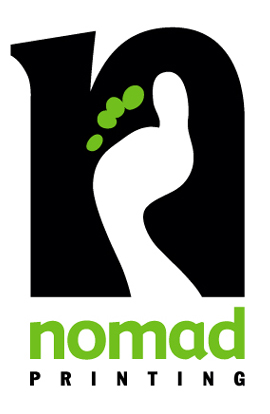
Nomad Printing and Services
last updated : 2003.02.11

|
Page Layout Help Nomad Printing and Services last updated : 2003.02.11 |
Other typefaces were made to be eye-catching and clean looking, without all those klunky serifs. These fonts are called sans-serif, like Helvetica, Futura, and Univers.
Some of the fonts on your computer are just pictures, little icons and ornaments. These are called dingbats, and they can be very useful to good design.
Most Computerized Fonts have two components, a bitmap file and a Postscript file. The bitmap is used to show the font on your computer screen, and the Postscript file is sent to a laser printer. It tells the printer how to make the shapes of the letters smooth and legible.
These fonts are called Postscript fonts, and most commercial printers won't accept any other kind. And if the font is corrupt or incomplete, you're print job won't get done, or worse still, get printed all wrong!
This is our next challenge to good print files.
Fonts substitute for COURIER if they are not included with your print job! Another type of font is the Truetype font, Macintoshes use these a lot.
The files for these fonts are smaller, and all the information to print a typeface is all contained in one file.
Unfortunately, TrueType fonts don't always consistently print how you'd expect. They can still be useful, and we'll learn some good type practices in the Illustrator section of this primer.
EXPLAINIATE LAYOUT APPLICATION CONCEPT
- make the page size the size of you project. You can bleed color off the edge if you need to.
- keep all design elements at least 1/8 inch (.125") away from the edge of the page. Almost all of our printing is gangrun (your card on a big sheet with many other jobs), so when we cut your card out of the big sheet, we don't want to cut into important information or graphics. While the trim is almost always right-on the page edge, cutting variance can happen. Keeping your important elements away from the edge of your card will ensure nothing critical will be compromised.
-Put the Front of you job on one page, and the back on another, or put the back in it's own quark document. Label these plainly.
- Include all fonts you use in your job. If you are using truetype fonts, be aware that uncommon/zany fonts may not image correctly when sent to a RIP. Also, for postcript fonts, be sure to collect the screen bitmap suitcase (containing the screen font, like "Helvetica 12" or "Copperplate Bold 36") and the laser component file (like "Helve" or "CoppeBolDTC").
- make sure all the art you use in your Quark document is in the correct color model. Most of the time this will be CMYK (Cyan, Magenta, Yellow, and Black: These are the standard process color printing inks). Make sure you bitmap art (Photoshop) is saved as a TIFF or EPS. Do not use jpegs, picts, gifs, etc in Quark. Printing these file formats can cause problems.
* RGB colorspace will not print correctly. RGB (Red, Green, Blue: The on-screen color model, has a different set of colors it can display than CMYK can print.
* Spot color is a different beast. We can print PANTONE colors, but extra costs and technical hurdles may be involved.
- Raster Art (illustrator) should also be in CMYK color-mode.
- Be sure to check for fonts embedded into eps documents, and outline them. Also, linking EPSes is preferable to embedding them.
- print color separations of your print job. Inspect them, pay special attention to overprint/trapping issues, art dropping out/not printing, etc.
Well, I haven't quite finished this section, so, if you
have a specific question about a feature or tool in Quark Xpress,
or page layout in general,
please feel free to email me at
[email protected].